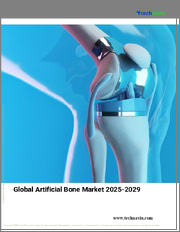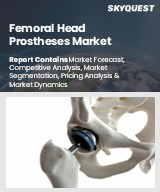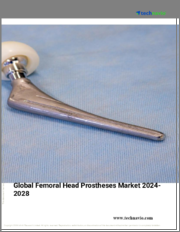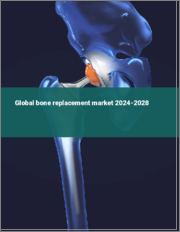
|
시장보고서
상품코드
1579386
세계의 인공뼈 시장 :재료 유형, 기술, 제품 유형, 용도, 최종 사용자별 예측(2025-2030년)Artificial Bone Market by Material Type (Ceramics, Composites, Metallic), Technology (3D Printing, Bioprinting, Nanotechnology), Product Type, Application, End User - Global Forecast 2025-2030 |
||||||
인공뼈 시장은 2023년에 16억 1,000만 달러로 평가되었고, 2024년에는 17억 달러에 달할 것으로 예측되며, 복합 연간 성장률(CAGR) 5.60%로 성장하여, 2030년에는 23억 7,000만 달러에 달할 것으로 예측됩니다.
인공뼈 시장은 의료 절차에서 손상된 뼈 조직을 대체하거나 복구하는 데 사용되는 생체 재료에 초점을 맞추어 정의됩니다. 세라믹, 폴리머 및 복합재료를 포함한 이러한 재료는 천연 뼈의 특성을 모방하며 정형외과, 치과 수술 및 척추 수술에 필수적입니다. 인공뼈의 필요성은 세계 인구의 고령화, 골변성 질환 증가, 사고 관련 부상 증가 등에 힘입어 혁신적인 골 복구 솔루션에 대한 수요를 증폭시키고 있습니다. 용도는 척추고정, 골절수복, 정형외과나 치과의 뼈 임플란트 등 다방면에 걸쳐, 병원, 진료소, 전문 외과 센터 등, 용도와 최종 용도의 양면에서 성장을 견인하고 있습니다.
| 주요 시장 통계 | |
|---|---|
| 기준년(2023) | 16억 1,000만 달러 |
| 예측년(2024) | 17억 달러 |
| 예측년(2030) | 23억 7,000만 달러 |
| 복합 연간 성장률(CAGR)(%) | 5.60% |
시장 인사이트에 따르면 재료 과학의 진보, 건강 관리 지출 증가, 대체 치료에 대한 의식 증가 등 성장에 영향을 미치는 몇 가지 요인이 밝혀졌습니다. 그러나 시장은 높은 개발 비용, 엄격한 규제 프레임 워크, 생체 적합성 문제 등의 제약에 직면하고 있으며, 이는 혁신의 속도를 저해하고 있습니다. 경쟁 구도은 생분해성 물질과 골전도성 물질의 지속적인 연구를 장려하며, 특히 바이오 통합 강화에 중점을 둡니다. 신흥국은 헬스케어 인프라 투자 증가와 의료 서비스의 향상을 요구하는 중간층의 인구 증가에 의해 큰 성장 기회를 가져오고 있습니다.
이러한 기회를 활용하기 위한 조사로는 연구기관과의 전략적 파트너십을 활용하는 것, 환자 고유의 요구에 맞는 커스텀 솔루션을 우선하는 것, 3D 프린팅 뼈나 나노테크놀로지 융합 복합재료 등 차세대 바이오머티리얼의 연구개발에 투자하는 등을 들 수 있습니다. 그럼에도 불구하고 급속한 기술 변화와 규제 변화를 특징으로 하는 시장의 특성은 시장 역학에 민첩한 적응의 중요성을 강조합니다. 기업은 장기적인 성장을 유지하기 위해 공급 체인 전반에 걸친 협력 관계를 촉진하고 진화하는 표준에 대한 컴플라이언스를 확보함으로써 이러한 과제를 극복해야 합니다. 종합하면 혁신, 규제 준수 및 시장 특유의 전략에 중점을 두어 기업은 진화하는 시장 상황에서 최적의 위치를 확보할 수 있습니다.
시장 역학: 빠르게 진화하는 인공뼈 시장의 주요 시장 인사이트 공개
인공뼈 시장은 수요 및 공급의 역동적인 상호작용에 의해 변모를 이루고 있습니다. 이러한 시장 역학의 진화를 이해함으로써 기업은 충분한 정보를 바탕으로 투자결정, 전략적 결정 정밀화, 새로운 비즈니스 기회 획득에 대비할 수 있습니다. 이러한 동향을 종합적으로 파악함으로써 기업은 정치적, 지리적, 기술적, 사회적, 경제적 영역에 걸친 다양한 리스크를 경감할 수 있을 뿐만 아니라 소비자 행동과 그것이 제조 비용 또는 구매 동향에 미치는 영향을보다 명확하게 이해할 수 있습니다.
- 시장 성장 촉진요인
- 정형외과 질환의 유병률 증가와 세계의 고령화율의 상승
- 환자와 의료 제공자 사이의 인공뼈 이식편에 대한 인식과 수용 증가
- 헬스케어 및 생물의학 연구에 대한 정부의 대처와 자금 지원
- 시장 성장 억제요인
- 감염증이나 이식편 거부반응 등 인공뼈이식편과 관련된 위험
- 시장 기회
- 인공뼈에 스마트 센서 등의 디지털 헬스 기술의 통합
- 3D 프린팅이나 커스텀 메이드 솔루션의 진보에 의한 개인화된 인공뼈 제품의 개발
- 생체적합성과 장수명의 인공뼈재료의 연구개발에 대한 투자 증가
- 시장의 과제
- 인공뼈 기술의 진보에 대한 의료 종사자의 인식과 전문 지식의 부족
- 인공뼈 솔루션과 기존의 의료 인프라와 치료 프로토콜의 통합에 있어서의 과제
Porter's Five Forces: 인공뼈 시장을 탐색하는 전략 도구
Porter's Five Forces Framework는 인공뼈 시장 경쟁 구도를 이해하는 중요한 도구입니다. Porter's Five Forces Framework는 기업의 경쟁력을 평가하고 전략적 기회를 탐구하는 명확한 기술을 제공합니다. 이 프레임워크는 기업이 시장 내 세력도를 평가하고 신규 사업의 수익성을 결정하는 데 도움이 됩니다. 이러한 통찰을 통해 기업은 자사의 강점을 활용하고, 약점을 해결하고, 잠재적인 과제를 피할 수 있으며, 보다 강인한 시장에서의 포지셔닝을 보장할 수 있습니다.
PESTLE 분석 : 인공뼈 시장의 외부 영향을 파악
외부 거시 환경 요인은 인공뼈 시장의 성과 역학을 형성하는 데 매우 중요한 역할을합니다. 정치적, 경제적, 사회적, 기술적, 법적, 환경적 요인 분석은 이러한 영향을 탐색하는 데 필요한 정보를 제공합니다. PESTLE 요인을 조사함으로써 기업은 잠재적인 위험과 기회를 더 잘 이해할 수 있습니다. 이 분석을 통해 기업은 규제, 소비자 선호, 경제 동향의 변화를 예측하고 앞으로 예상되는 적극적인 의사 결정을 할 준비를 할 수 있습니다.
시장 점유율 분석 인공뼈 시장 경쟁 구도 파악
인공뼈 시장의 상세한 시장 점유율 분석을 통해 공급업체의 성과를 종합적으로 평가할 수 있습니다. 기업은 수익, 고객 기반, 성장률 등 주요 지표를 비교하여 경쟁 포지셔닝을 밝힐 수 있습니다. 이 분석을 통해 시장 집중, 단편화, 통합 동향을 밝혀내고 공급업체는 경쟁이 치열해지면서 자사의 지위를 높이는 전략적 의사 결정을 내리는 데 필요한 지식을 얻을 수 있습니다.
FPNV 포지셔닝 매트릭스 인공뼈 시장에서 공급업체의 성능 평가
FPNV 포지셔닝 매트릭스는 인공뼈 시장에서 공급업체를 평가하는 중요한 도구입니다. 이 행렬을 통해 비즈니스 조직은 공급업체의 비즈니스 전략과 제품 만족도를 기준으로 평가하여 목표에 맞는 충분한 정보를 바탕으로 의사 결정을 내릴 수 있습니다. 네 가지 사분면을 통해 공급업체를 명확하고 정확하게 세분화하여 전략 목표에 가장 적합한 파트너 및 솔루션을 파악할 수 있습니다.
전략 분석 및 추천 인공뼈 시장에서 성공을 위한 길을 그리기
인공뼈 시장의 전략분석은 시장에서의 프레즌스 강화를 목표로 하는 기업에 필수적입니다. 주요 자원, 능력 및 성과 지표를 검토함으로써 기업은 성장 기회를 파악하고 개선을 위해 노력할 수 있습니다. 이러한 접근 방식을 통해 경쟁 구도에서 과제를 극복하고 새로운 비즈니스 기회를 활용하여 장기적인 성공을 거둘 수 있는 체제를 구축할 수 있습니다.
이 보고서는 주요 관심 분야를 포괄하는 시장의 종합적인 분석을 제공합니다.
1. 시장 침투 : 현재 시장 환경의 상세한 검토, 주요 기업의 광범위한 데이터, 시장 도달범위 및 전반적인 영향력 평가.
2. 시장 개척도 : 신흥 시장의 성장 기회를 파악하고 기존 분야의 확장 가능성을 평가하며 미래 성장을 위한 전략적 로드맵을 제공합니다.
3. 시장 다양화 : 최근 제품 출시, 미개척 지역, 업계의 주요 진보, 시장을 형성하는 전략적 투자를 분석합니다.
4. 경쟁 평가 및 정보 : 경쟁 구도를 철저히 분석하여 시장 점유율, 사업 전략, 제품 포트폴리오, 인증, 규제 당국 승인, 특허 동향, 주요 기업의 기술 진보 등을 검증합니다.
5. 제품 개발 및 혁신 : 미래 시장 성장을 가속할 것으로 예상되는 최첨단 기술, R&D 활동, 제품 혁신을 강조합니다.
또한 이해관계자가 충분한 정보를 얻고 의사결정을 할 수 있도록 중요한 질문에 대답하고 있습니다.
1. 현재 시장 규모와 향후 성장 예측은?
2. 최고의 투자 기회를 제공하는 제품, 부문 및 지역은 어디입니까?
3. 시장을 형성하는 주요 기술 동향과 규제의 영향은?
4. 주요 벤더의 시장 점유율과 경쟁 포지션은?
5. 벤더 시장 진입, 철수 전략의 원동력이 되는 수익원과 전략적 기회는 무엇인가?
목차
제1장 서문
제2장 조사 방법
제3장 주요 요약
제4장 시장 개요
제5장 시장 인사이트
- 시장 역학
- 성장 촉진요인
- 세계적으로 정형외과 질환의 이환율이 증가하고, 고령화가 진행되고 있다
- 환자와 헬스케어 종사자 사이의 인공뼈 이식에 대한 인식과 수용의 향상
- 헬스케어와 생물의학 조사에 대한 정부의 대처와 자금 제공
- 억제요인
- 감염증이나 이식편 거절 반응 등의 이식에 수반되는 위험
- 기회
- 인공뼈에 스마트 센서 등의 디지털 헬스 기술의 통합
- 3D 프린팅와 커스텀 메이드 솔루션의 진보에 의한 개인화된 인공뼈 제품의 개발
- 생체적합성과 내구성이 뛰어난 인공뼈재료의 연구개발에 대한 투자 증가
- 과제
- 헬스케어 종사자의 사이에서 인공뼈 기술의 진보에 관한 인식과 전문 지식이 부족하다
- 인공뼈 솔루션을 기존의 의료 인프라 및 치료 프로토콜과 통합할 때의 과제
- 성장 촉진요인
- 시장 세분화 분석
- 용도: 열화된 관절을 치환 또는 서포트하는 관절 재건에 있어서의 인공뼈 수요 증가
- 재료 유형: 골 이식에 있어서의 인산칼슘 세라믹 재료의 이용 증가
- Porter's Five Forces 분석
- PESTEL 분석
- 정치적
- 경제
- 사교
- 기술적
- 법률상
- 환경
제6장 인공뼈 시장 : 소재 유형별
- 도예
- 인산칼슘 세라믹
- 지르코니아계 세라믹
- 복합재료
- 금속 세라믹 복합재료
- 폴리머 세라믹 복합재료
- 메탈릭
- 스테인리스 스틸계 합금
- 티타늄계 합금
- 폴리머
- 생분해성 폴리머
- 비생분해성 폴리머
제7장 인공뼈 시장 : 기술별
- 3D 프린팅
- 바이오프린팅
- 나노기술
- 플라즈마 용사
제8장 인공뼈 시장 : 제품 유형별
- 골형성 단백질(BMP)
- 탈회골 기질(DBM)
- 줄기 세포를 이용한 뼈 이식
- 인공뼈 이식
제9장 인공뼈 시장 : 용도별
- 두개턱 안면
- 치과
- 관절 재건
- 정형외과
- 척추 수술
- 외상
제10장 인공뼈 시장 : 최종 사용자별
- 외래수술센터(ASC)
- 병원
- 조사, 학술 기관
- 전문 클리닉
제11장 아메리카의 인공뼈 시장
- 아르헨티나
- 브라질
- 캐나다
- 멕시코
- 미국
제12장 아시아태평양의 인공뼈 시장
- 호주
- 중국
- 인도
- 인도네시아
- 일본
- 말레이시아
- 필리핀
- 싱가포르
- 한국
- 대만
- 태국
- 베트남
제13장 유럽, 중동 및 아프리카의 인공뼈 시장
- 덴마크
- 이집트
- 핀란드
- 프랑스
- 독일
- 이스라엘
- 이탈리아
- 네덜란드
- 나이지리아
- 노르웨이
- 폴란드
- 카타르
- 러시아
- 사우디아라비아
- 남아프리카
- 스페인
- 스웨덴
- 스위스
- 터키
- 아랍에미리트(UAE)
- 영국
제14장 경쟁 구도
- 시장 점유율 분석(2023년)
- FPNV 포지셔닝 매트릭스(2023년)
- 경쟁 시나리오 분석
- AstraZeneca, Amolyt Pharma의 10억 5,000만 달러의 인수를 완료
- SIIF Impact Capital은 노인의 골절 치료를 개선하기 위해 ORTHOREBIRTH의 혁신적인 ReBOSSIS에 투자했습니다.
- Vinmec 병원이 3D 프린팅 인공뼈을 사용한 획기적인 수술을 실시
- 전략 분석과 제안
기업 목록
- Advanced Medical Solutions Group plc
- Aesculap, Inc.
- Allosource
- B. Braun Melsungen AG by Octane Medical Group
- Bando Chemical Industries Ltd.
- baxter International, Inc.
- Bioventus LLC
- Bone Biologics Corp
- ConforMIS, Inc. by restor3d
- curasan AG
- Exactech, Inc.
- Globus Medical, Inc.
- Graftys SA
- Integra LifeSciences Holdings Corporation
- Johnson &Johnson
- Medtronic plc
- NovaBone by Halma PLC
- NuVasive, Inc.
- Orthofix Medical Inc.
- OssDsign AB
- Ossur hf.
- RTI Surgical Holdings, Inc.
- Smith & Nephew plc
- Stryker Corporation
- Zimmer Biomet Holdings, Inc.
The Artificial Bone Market was valued at USD 1.61 billion in 2023, expected to reach USD 1.70 billion in 2024, and is projected to grow at a CAGR of 5.60%, to USD 2.37 billion by 2030.
The artificial bone market is defined by its focus on biomaterials used to replace or repair damaged bone tissues in medical procedures. These materials, which include ceramics, polymers, and composites, mimic the properties of natural bones and are essential for orthopedics, dental surgeries, and spinal procedures. The necessity for artificial bones is underpinned by an aging global population, rising incidences of bone degeneration diseases, and increased accident-related injuries, which amplify the demand for innovative bone repair solutions. Applications extend across vertebral fusion, fracture repair, and bone implants in orthopedic and dental sectors, driving growth from both an application and end-use perspective, including hospitals, clinics, and specialized surgical centers.
| KEY MARKET STATISTICS | |
|---|---|
| Base Year [2023] | USD 1.61 billion |
| Estimated Year [2024] | USD 1.70 billion |
| Forecast Year [2030] | USD 2.37 billion |
| CAGR (%) | 5.60% |
Market insights reveal several factors influencing growth, such as advancements in material science, growing healthcare expenditure, and heightened awareness about treatment alternatives. However, the market faces limitations like high development costs, stringent regulatory frameworks, and biocompatibility issues, which can impede the pace of innovation. The competitive landscape encourages continuous research into biodegradable and osteoconductive materials, with particular focus on enhancing biointegration. Emerging economies provide significant growth opportunities due to increased healthcare infrastructure investment and a growing middle-class population demanding improved medical services.
Recommendations for capitalizing on these opportunities include leveraging strategic partnerships with research institutions, prioritizing custom solutions adapted to patient-specific needs, and investing in R&D for next-generation biomaterials like 3D-printed bones and nanotechnology-infused composites. Nevertheless, the market's nature, characterized by rapid technological shifts and regulatory changes, underscores the importance of agile adaptation to market dynamics. Businesses must navigate these challenges by fostering collaboration across the supply chain and ensuring compliance with evolving standards to sustain long-term growth. In summary, focusing on innovation, regulatory compliance, and market-specific strategies can help businesses optimally position themselves in the evolving artificial bone market landscape.
Market Dynamics: Unveiling Key Market Insights in the Rapidly Evolving Artificial Bone Market
The Artificial Bone Market is undergoing transformative changes driven by a dynamic interplay of supply and demand factors. Understanding these evolving market dynamics prepares business organizations to make informed investment decisions, refine strategic decisions, and seize new opportunities. By gaining a comprehensive view of these trends, business organizations can mitigate various risks across political, geographic, technical, social, and economic domains while also gaining a clearer understanding of consumer behavior and its impact on manufacturing costs and purchasing trends.
- Market Drivers
- Increasing prevalence of orthopedic diseases and rising aging population globally
- Increasing awareness and acceptance of artificial bone grafts among patients and healthcare providers
- Government initiatives and funding for healthcare and biomedical research
- Market Restraints
- Risks associated with artificial bone grafts, such as infections and graft rejection
- Market Opportunities
- Integration of digital health technologies such as smart sensors in artificial bones
- Development of personalized artificial bone products with advances in 3D printing and custom-made solutions
- Increasing investment in research and development for bio-compatible and longer-lasting artificial bone materials
- Market Challenges
- Lack of awareness and expertise among healthcare professionals about advancements in artificial bone technologies
- Challenges in integrating artificial bone solutions with existing medical infrastructure and treatment protocols
Porter's Five Forces: A Strategic Tool for Navigating the Artificial Bone Market
Porter's five forces framework is a critical tool for understanding the competitive landscape of the Artificial Bone Market. It offers business organizations with a clear methodology for evaluating their competitive positioning and exploring strategic opportunities. This framework helps businesses assess the power dynamics within the market and determine the profitability of new ventures. With these insights, business organizations can leverage their strengths, address weaknesses, and avoid potential challenges, ensuring a more resilient market positioning.
PESTLE Analysis: Navigating External Influences in the Artificial Bone Market
External macro-environmental factors play a pivotal role in shaping the performance dynamics of the Artificial Bone Market. Political, Economic, Social, Technological, Legal, and Environmental factors analysis provides the necessary information to navigate these influences. By examining PESTLE factors, businesses can better understand potential risks and opportunities. This analysis enables business organizations to anticipate changes in regulations, consumer preferences, and economic trends, ensuring they are prepared to make proactive, forward-thinking decisions.
Market Share Analysis: Understanding the Competitive Landscape in the Artificial Bone Market
A detailed market share analysis in the Artificial Bone Market provides a comprehensive assessment of vendors' performance. Companies can identify their competitive positioning by comparing key metrics, including revenue, customer base, and growth rates. This analysis highlights market concentration, fragmentation, and trends in consolidation, offering vendors the insights required to make strategic decisions that enhance their position in an increasingly competitive landscape.
FPNV Positioning Matrix: Evaluating Vendors' Performance in the Artificial Bone Market
The Forefront, Pathfinder, Niche, Vital (FPNV) Positioning Matrix is a critical tool for evaluating vendors within the Artificial Bone Market. This matrix enables business organizations to make well-informed decisions that align with their goals by assessing vendors based on their business strategy and product satisfaction. The four quadrants provide a clear and precise segmentation of vendors, helping users identify the right partners and solutions that best fit their strategic objectives.
Strategy Analysis & Recommendation: Charting a Path to Success in the Artificial Bone Market
A strategic analysis of the Artificial Bone Market is essential for businesses looking to strengthen their global market presence. By reviewing key resources, capabilities, and performance indicators, business organizations can identify growth opportunities and work toward improvement. This approach helps businesses navigate challenges in the competitive landscape and ensures they are well-positioned to capitalize on newer opportunities and drive long-term success.
Key Company Profiles
The report delves into recent significant developments in the Artificial Bone Market, highlighting leading vendors and their innovative profiles. These include Advanced Medical Solutions Group plc, Aesculap, Inc., Allosource, B. Braun Melsungen AG by Octane Medical Group, Bando Chemical Industries Ltd., baxter International, Inc., Bioventus LLC, Bone Biologics Corp, ConforMIS, Inc. by restor3d, curasan AG, Exactech, Inc., Globus Medical, Inc., Graftys SA, Integra LifeSciences Holdings Corporation, Johnson &Johnson, Medtronic plc, NovaBone by Halma PLC, NuVasive, Inc., Orthofix Medical Inc., OssDsign AB, Ossur hf., RTI Surgical Holdings, Inc., Smith & Nephew plc, Stryker Corporation, and Zimmer Biomet Holdings, Inc..
Market Segmentation & Coverage
This research report categorizes the Artificial Bone Market to forecast the revenues and analyze trends in each of the following sub-markets:
- Based on Material Type, market is studied across Ceramics, Composites, Metallic, and Polymers. The Ceramics is further studied across Calcium Phosphate Ceramics and Zirconia-Based Ceramics. The Composites is further studied across Metal-Ceramic Composites and Polymer-Ceramic Composites. The Metallic is further studied across Stainless Steel-Based Alloys and Titanium-Based Alloys. The Polymers is further studied across Biodegradable Polymers and Non-Biodegradable Polymers.
- Based on Technology, market is studied across 3D Printing, Bioprinting, Nanotechnology, and Plasma Spraying.
- Based on Product Type, market is studied across Bone Morphogenetic Protein (BMP), Demineralized Bone Matrix (DBM), Stem Cell-Based Bone Grafts, and Synthetic Bone Grafts.
- Based on Application, market is studied across Craniomaxillofacial, Dental, Joint Reconstruction, Orthopedic Surgery, Spinal Surgery, and Trauma.
- Based on End User, market is studied across Ambulatory Surgical Centers, Hospitals, Research and Academic Institutions, and Specialty Clinics.
- Based on Region, market is studied across Americas, Asia-Pacific, and Europe, Middle East & Africa. The Americas is further studied across Argentina, Brazil, Canada, Mexico, and United States. The United States is further studied across California, Florida, Illinois, New York, Ohio, Pennsylvania, and Texas. The Asia-Pacific is further studied across Australia, China, India, Indonesia, Japan, Malaysia, Philippines, Singapore, South Korea, Taiwan, Thailand, and Vietnam. The Europe, Middle East & Africa is further studied across Denmark, Egypt, Finland, France, Germany, Israel, Italy, Netherlands, Nigeria, Norway, Poland, Qatar, Russia, Saudi Arabia, South Africa, Spain, Sweden, Switzerland, Turkey, United Arab Emirates, and United Kingdom.
The report offers a comprehensive analysis of the market, covering key focus areas:
1. Market Penetration: A detailed review of the current market environment, including extensive data from top industry players, evaluating their market reach and overall influence.
2. Market Development: Identifies growth opportunities in emerging markets and assesses expansion potential in established sectors, providing a strategic roadmap for future growth.
3. Market Diversification: Analyzes recent product launches, untapped geographic regions, major industry advancements, and strategic investments reshaping the market.
4. Competitive Assessment & Intelligence: Provides a thorough analysis of the competitive landscape, examining market share, business strategies, product portfolios, certifications, regulatory approvals, patent trends, and technological advancements of key players.
5. Product Development & Innovation: Highlights cutting-edge technologies, R&D activities, and product innovations expected to drive future market growth.
The report also answers critical questions to aid stakeholders in making informed decisions:
1. What is the current market size, and what is the forecasted growth?
2. Which products, segments, and regions offer the best investment opportunities?
3. What are the key technology trends and regulatory influences shaping the market?
4. How do leading vendors rank in terms of market share and competitive positioning?
5. What revenue sources and strategic opportunities drive vendors' market entry or exit strategies?
Table of Contents
1. Preface
- 1.1. Objectives of the Study
- 1.2. Market Segmentation & Coverage
- 1.3. Years Considered for the Study
- 1.4. Currency & Pricing
- 1.5. Language
- 1.6. Stakeholders
2. Research Methodology
- 2.1. Define: Research Objective
- 2.2. Determine: Research Design
- 2.3. Prepare: Research Instrument
- 2.4. Collect: Data Source
- 2.5. Analyze: Data Interpretation
- 2.6. Formulate: Data Verification
- 2.7. Publish: Research Report
- 2.8. Repeat: Report Update
3. Executive Summary
4. Market Overview
5. Market Insights
- 5.1. Market Dynamics
- 5.1.1. Drivers
- 5.1.1.1. Increasing prevalence of orthopedic diseases and rising aging population globally
- 5.1.1.2. Increasing awareness and acceptance of artificial bone grafts among patients and healthcare providers
- 5.1.1.3. Government initiatives and funding for healthcare and biomedical research
- 5.1.2. Restraints
- 5.1.2.1. Risks associated with artificial bone grafts, such as infections and graft rejection
- 5.1.3. Opportunities
- 5.1.3.1. Integration of digital health technologies such as smart sensors in artificial bones
- 5.1.3.2. Development of personalized artificial bone products with advances in 3D printing and custom-made solutions
- 5.1.3.3. Increasing investment in research and development for bio-compatible and longer-lasting artificial bone materials
- 5.1.4. Challenges
- 5.1.4.1. Lack of awareness and expertise among healthcare professionals about advancements in artificial bone technologies
- 5.1.4.2. Challenges in integrating artificial bone solutions with existing medical infrastructure and treatment protocols
- 5.1.1. Drivers
- 5.2. Market Segmentation Analysis
- 5.2.1. Application: Increasing demand for artificial bone in joint reconstruction to replace or support deteriorated joints
- 5.2.2. Material Type: Increasing utilization of calcium phosphate ceramics material in bone grafts
- 5.3. Porter's Five Forces Analysis
- 5.3.1. Threat of New Entrants
- 5.3.2. Threat of Substitutes
- 5.3.3. Bargaining Power of Customers
- 5.3.4. Bargaining Power of Suppliers
- 5.3.5. Industry Rivalry
- 5.4. PESTLE Analysis
- 5.4.1. Political
- 5.4.2. Economic
- 5.4.3. Social
- 5.4.4. Technological
- 5.4.5. Legal
- 5.4.6. Environmental
6. Artificial Bone Market, by Material Type
- 6.1. Introduction
- 6.2. Ceramics
- 6.2.1. Calcium Phosphate Ceramics
- 6.2.2. Zirconia-Based Ceramics
- 6.3. Composites
- 6.3.1. Metal-Ceramic Composites
- 6.3.2. Polymer-Ceramic Composites
- 6.4. Metallic
- 6.4.1. Stainless Steel-Based Alloys
- 6.4.2. Titanium-Based Alloys
- 6.5. Polymers
- 6.5.1. Biodegradable Polymers
- 6.5.2. Non-Biodegradable Polymers
7. Artificial Bone Market, by Technology
- 7.1. Introduction
- 7.2. 3D Printing
- 7.3. Bioprinting
- 7.4. Nanotechnology
- 7.5. Plasma Spraying
8. Artificial Bone Market, by Product Type
- 8.1. Introduction
- 8.2. Bone Morphogenetic Protein (BMP)
- 8.3. Demineralized Bone Matrix (DBM)
- 8.4. Stem Cell-Based Bone Grafts
- 8.5. Synthetic Bone Grafts
9. Artificial Bone Market, by Application
- 9.1. Introduction
- 9.2. Craniomaxillofacial
- 9.3. Dental
- 9.4. Joint Reconstruction
- 9.5. Orthopedic Surgery
- 9.6. Spinal Surgery
- 9.7. Trauma
10. Artificial Bone Market, by End User
- 10.1. Introduction
- 10.2. Ambulatory Surgical Centers
- 10.3. Hospitals
- 10.4. Research and Academic Institutions
- 10.5. Specialty Clinics
11. Americas Artificial Bone Market
- 11.1. Introduction
- 11.2. Argentina
- 11.3. Brazil
- 11.4. Canada
- 11.5. Mexico
- 11.6. United States
12. Asia-Pacific Artificial Bone Market
- 12.1. Introduction
- 12.2. Australia
- 12.3. China
- 12.4. India
- 12.5. Indonesia
- 12.6. Japan
- 12.7. Malaysia
- 12.8. Philippines
- 12.9. Singapore
- 12.10. South Korea
- 12.11. Taiwan
- 12.12. Thailand
- 12.13. Vietnam
13. Europe, Middle East & Africa Artificial Bone Market
- 13.1. Introduction
- 13.2. Denmark
- 13.3. Egypt
- 13.4. Finland
- 13.5. France
- 13.6. Germany
- 13.7. Israel
- 13.8. Italy
- 13.9. Netherlands
- 13.10. Nigeria
- 13.11. Norway
- 13.12. Poland
- 13.13. Qatar
- 13.14. Russia
- 13.15. Saudi Arabia
- 13.16. South Africa
- 13.17. Spain
- 13.18. Sweden
- 13.19. Switzerland
- 13.20. Turkey
- 13.21. United Arab Emirates
- 13.22. United Kingdom
14. Competitive Landscape
- 14.1. Market Share Analysis, 2023
- 14.2. FPNV Positioning Matrix, 2023
- 14.3. Competitive Scenario Analysis
- 14.3.1. AstraZeneca completes USD 1.05 billion acquisition of Amolyt Pharma
- 14.3.2. SIIF Impact Capital invests in ORTHOREBIRTH's innovative ReBOSSIS to improve elderly bone fracture care
- 14.3.3. Vinmec Hospital performs groundbreaking surgery using 3D-printed artificial bones
- 14.4. Strategy Analysis & Recommendation
Companies Mentioned
- 1. Advanced Medical Solutions Group plc
- 2. Aesculap, Inc.
- 3. Allosource
- 4. B. Braun Melsungen AG by Octane Medical Group
- 5. Bando Chemical Industries Ltd.
- 6. baxter International, Inc.
- 7. Bioventus LLC
- 8. Bone Biologics Corp
- 9. ConforMIS, Inc. by restor3d
- 10. curasan AG
- 11. Exactech, Inc.
- 12. Globus Medical, Inc.
- 13. Graftys SA
- 14. Integra LifeSciences Holdings Corporation
- 15. Johnson &Johnson
- 16. Medtronic plc
- 17. NovaBone by Halma PLC
- 18. NuVasive, Inc.
- 19. Orthofix Medical Inc.
- 20. OssDsign AB
- 21. Ossur hf.
- 22. RTI Surgical Holdings, Inc.
- 23. Smith & Nephew plc
- 24. Stryker Corporation
- 25. Zimmer Biomet Holdings, Inc.



















